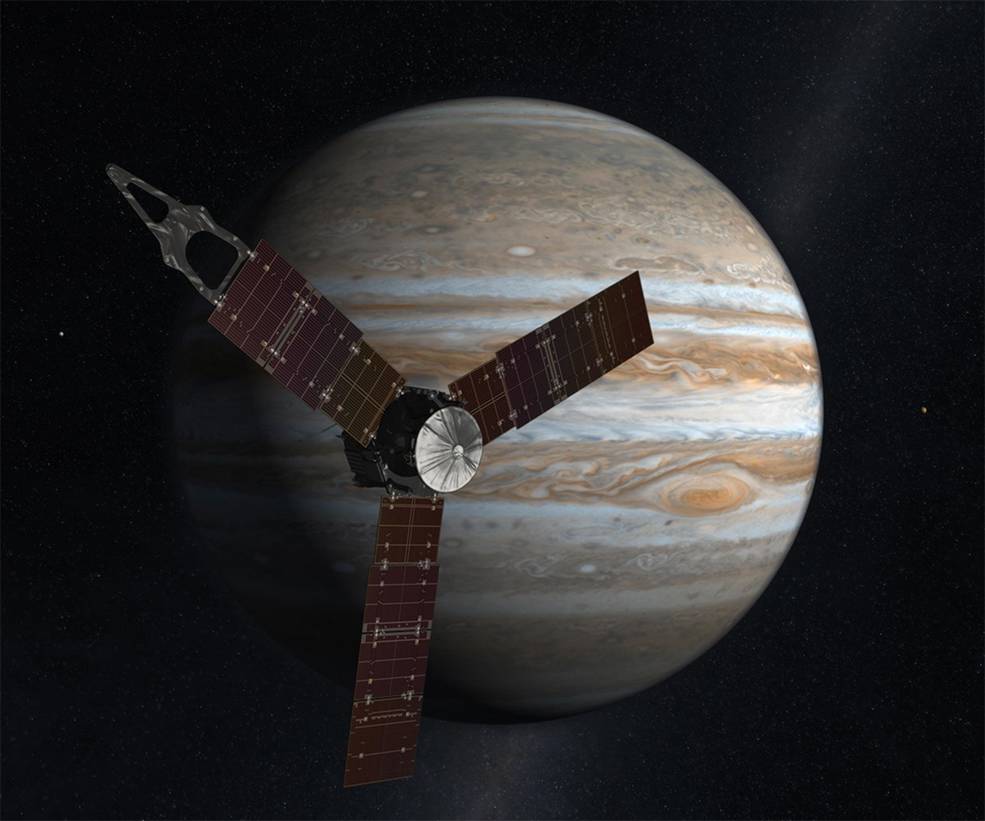
The spacecraft can now begin a series of observations of the conditions below the planet’s swirling cloud systems and into the interior structure of the Solar System’s largest planet. One of the most crucial components of the orbital insertion manoeuvre, a British-made rocket engine, worked perfectly despite the ferocious radiation levels close to Jupiter.
Jupiter, with its many moons orbiting the giant planet composed mainly of hydrogen, has for centuries been considered as model for the entire Solar System; it was Galileo Galilei’s extrapolation of his observations of the orbits of the four largest moons in the 15th century that led to him supporting the heliocentric model of the System, founding the modern science of observational astronomy and in turn, landing him in so much trouble with the Catholic Church.
The Juno mission is an expansion of this, designed in part to test theories about the early history of the Solar System: it is believed by some that Jupiter originally formed much closer to, or further away from the Sun, and gradually moved to its current orbit. Juno carries eight instruments that will look down onto the planet from its orbit, which is designed to avoid the highest radiation regions Jupiter, and measure its gravity, the abundance of oxygen and hence water in its composition, its magnetic fields (the largest of any of our planetary neighbours), and determine the composition of its atmosphere and lower layers. It will also take the closest images of Jupiter yet obtained when it moves into an even smaller orbit in October, a few thousand kilometres above the top of its atmosphere. The water levels are key to determining where the planet - believed to be the oldest in the solar system – formed.
The orbital insertion depended on the main engine of the 20m-diameter spacecraft, a Leros-1b liquid fuelled rocket engine made by Moog-ISP of Westcott in Bucks. One of the space industries most trusted workhorses, the Leros-1b has a history dating back to the Mercury missions of the late 1950s and early 1960s; originally developed by Lockheed Martin, it became part of the Moog group after passing through a series of other companies.
The Leros-1b is an apogee engine, which fires at the point in a spacecraft’s elliptical orbit when it is furthest from the planet, bringing its orbit closer to the planet. It’s most typically used on geostationary communications satellites to change the shape of their orbits from elliptical to circular, and generates 635N of thrust, making it the mot powerful apogee engine available.
The engine is essentially an off-the-shelf item, Moog-ISP’s chief engineer, Ian Coxhill, told The Engineer; although each engine is tuned for the specific thrust required for its mission and fitted with certain critical components to ensure it can meet its requirements. Moog builds about four Leros engines per year, mainly for commercial telecommunications satellites, although it has developed a variant version for ESA missions and is looking at a further development using different propellants to obtain twice the thrust, Coxhill added.
The engine has already played one crucial role in Juno’s mission in 2012, when it put the spacecraft in ‘slingshot’ orbit around the Earth, using its gravity to set it on its course to Jupiter. In the early hours of this morning it fired again, under control of a pre-programmed system, to brake the spacecraft to place it into orbit. The engine had to burn for precisely 35 minutes; any error and Juno would have skipped off Jupiter’s atmosphere and into deep space. There were concerns that intense radiation could have interfered with Juno’s electronics, but its vital components are shielded behind titanium and appear to have been unaffected.
“It seems to have performed perfectly,” Coxhill, said. “We’re told there was only 0.3 per cent difference between the predicted performance and the result. We don’t get invited to Mission Control but we were all watching on NASA TV and we would certainly have been on call if anything were to go wrong.”
Fingers will now remain crossed for October’s manoeuvre, which will take Juno further into Jupiter’s ferocious environment than any spacecraft has been. The mission is scheduled to end by crashing the probe into the plane, to prevent a possible collision with the moons Europa and Callisto, which may have biospheres that could potentially be contaminated by the spacecraft.




Red Bull makes hydrogen fuel cell play with AVL
Surely EVs are the best solution for motor sports and for weight / performance dispense with the battery altogether by introducing paired conductors...